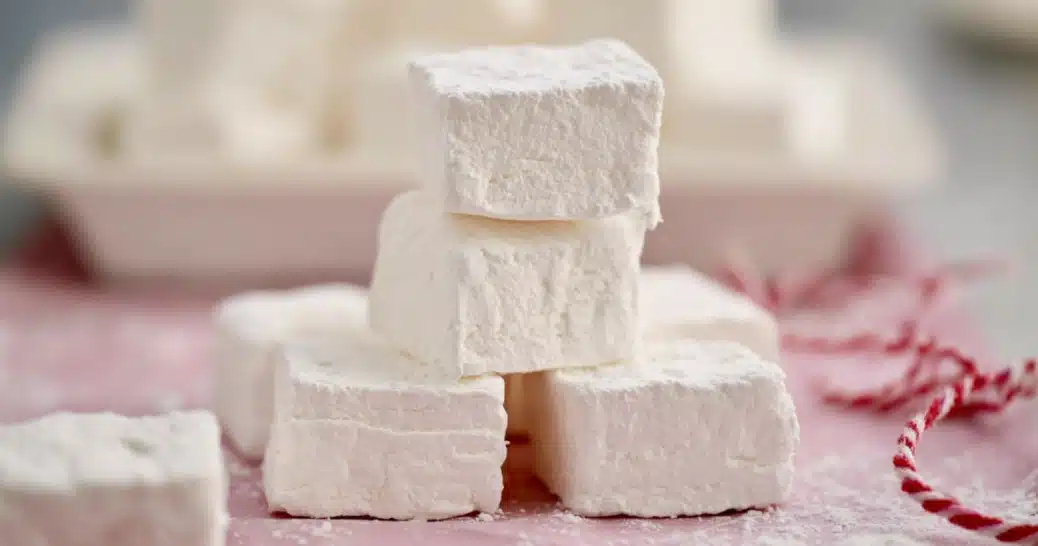Ever craved a soft, sweet marshmallow but couldn’t enjoy the store-bought kind because they contain gelatin? You’re not alone. Many people following vegan, halal, or kosher lifestyles are constantly looking for desserts that fit their dietary choices without compromising on taste. The good news is that you can make your own delicious, fluffy marshmallows right at home, completely free from animal products.
This guide reveals everything you need to know about creating the perfect marshmallow recipe without gelatin, from ingredients and techniques to expert tips and variations. You’ll learn how to replace gelatin with plant-based alternatives like agar agar and aquafaba and still achieve that soft, airy texture that makes marshmallows irresistible. Whether you’re preparing them for hot cocoa, s’mores, or snacking straight from the jar, these homemade treats are sure to impress.
Table of Contents
Why Make Marshmallows Without Gelatin?
Understanding Gelatin and Why It’s Avoided
Traditional marshmallows get their signature bounce from gelatin, a gelling agent derived from animal collagen. This means they’re off-limits for anyone who avoids animal-based ingredients. But gelatin-free marshmallows are changing that. By using substitutes like agar agar, pectin, or marshmallow root, you can achieve the same airy texture while keeping your recipe 100% plant-based. Making your own marshmallow recipe without gelatin not only allows for better ingredient control but also lets you enjoy treats that align with your values and dietary needs.
Dietary and Ethical Reasons for a Gelatin-Free Marshmallow Recipe
More people are turning to plant-based eating for ethical, environmental, or health reasons. Removing gelatin from your desserts supports sustainable food choices and expands access for everyone, from vegans to those following halal or kosher diets. A gelatin-free marshmallow recipe ensures that no one feels left out, whether you’re serving at family gatherings, kids’ parties, or festive events. Beyond ethics, this approach helps avoid allergens found in some animal-derived ingredients while supporting cleaner, cruelty-free baking practices.
Health and Lifestyle Benefits of Making Marshmallows Without Gelatin
Homemade marshmallows without gelatin aren’t just about inclusivity—they can also be healthier. You’ll skip artificial additives and preservatives often found in store-bought brands. Plus, by choosing natural sweeteners like maple syrup or agave nectar, you can make a lighter, more wholesome treat. The texture may be slightly softer than traditional versions, but the melt-in-your-mouth experience remains just as delightful. If you’ve been searching for a vegan marshmallow recipe that’s simple, satisfying, and free from gelatin, this method gives you full control over flavor and sweetness while keeping things light and natural.
Key Ingredients for a Marshmallow Recipe Without Gelatin
Print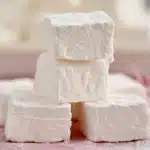
Marshmallow Recipe Without Gelatin: A Fluffy Vegan Dessert You’ll Love
- Total Time: 35 minutes
- Yield: 16 marshmallows 1x
- Diet: Vegan
Description
Soft, fluffy vegan marshmallows made without gelatin using aquafaba and agar agar. Perfect for hot cocoa, s’mores, or sweet gifting.
Ingredients
¾ cup aquafaba (chickpea brine, unsalted, room temperature)
½ tsp cream of tartar
1 ½ cups white sugar
½ cup water
1 tbsp agar agar powder (not flakes)
1 tsp vanilla extract
¼ cup cornstarch
¼ cup powdered sugar (for dusting, mixed with cornstarch)
Instructions
1. Whip aquafaba and cream of tartar with a stand mixer until stiff peaks form.
2. In a saucepan, combine sugar, water, and agar agar powder. Bring to a boil, then simmer 4–5 minutes until 225°F–230°F.
3. Slowly pour the syrup into the whipped aquafaba while mixing on low, then increase to high until thick and glossy. Add vanilla in the last minute.
4. Dust an 8×8” pan with cornstarch and powdered sugar mix.
5. Pour mixture quickly into the pan and spread evenly. Let it set at room temperature for 4–6 hours.
6. Once set, dust the top with more sugar mix. Remove slab, cut into cubes, and coat all sides before serving.
Notes
Use fresh, room-temperature aquafaba for best results. Make sure to simmer the agar syrup long enough to activate it. Store your marshmallows in an airtight container at room temperature for up to 7 days.
- Prep Time: 30 minutes
- Cook Time: 5 minutes
- Category: Dessert
- Method: No Bake
- Cuisine: Vegan
Nutrition
- Serving Size: 1 marshmallow
- Calories: 45
- Sugar: 9g
- Sodium: 5mg
- Fat: 0g
- Saturated Fat: 0g
- Unsaturated Fat: 0g
- Trans Fat: 0g
- Carbohydrates: 10g
- Fiber: 0g
- Protein: 0g
- Cholesterol: 0mg
Creating the perfect marshmallow recipe without gelatin is all about understanding your ingredients. Since gelatin gives traditional marshmallows their structure, the right substitutes are essential for achieving that soft, springy texture we all love. With a few plant-based swaps, you can make fluffy, stable marshmallows that taste just as good as the classic version.
Agar Agar: The Perfect Vegan Gelatin Substitute
Agar agar is a natural gelling agent derived from red seaweed. It’s the most popular alternative to gelatin in vegan recipes because it sets firmly and holds its shape beautifully. When used correctly, agar creates a smooth, elastic consistency without any animal products.
How to use it:
- Bloom 1 tablespoon of agar agar powder in ½ cup of water.
- Bring it to a full boil to activate its gelling power.
- Combine it with sugar syrup to create the base for your marshmallows.
Pro tip: Agar agar sets more firmly than gelatin, so a smaller amount often works better. Too much can make the texture rubbery.
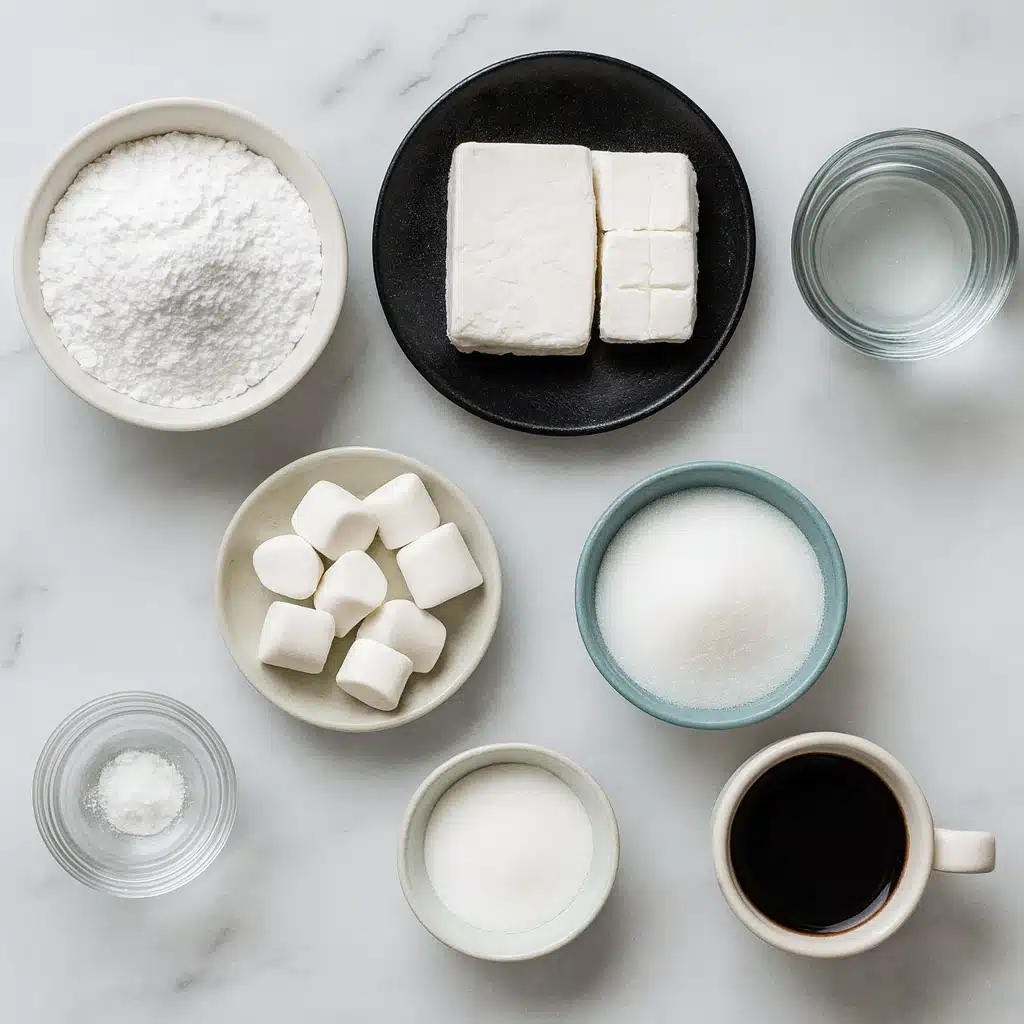
Aquafaba: The Secret Ingredient for Fluffy Marshmallows
Aquafaba is the liquid found in canned chickpeas, and it’s one of the most magical ingredients in vegan baking. When whipped, it forms stiff peaks just like egg whites, giving marshmallows that signature airiness.
Why it works:
Aquafaba traps air bubbles and stabilizes them, creating the same light, pillowy structure you’d expect from gelatin-based marshmallows.
How to use it:
- Whip ¾ cup of aquafaba with ½ teaspoon of cream of tartar until stiff peaks form.
- Slowly add your hot agar-sugar syrup while continuing to whip.
- Once thick and glossy, you’ll have a perfect marshmallow base ready to set.
Other Gelatin-Free Gelling Agents You Can Use
While agar agar and aquafaba are the most common pair, there are other plant-based thickeners that can work in your marshmallow recipe without gelatin.
- Pectin: A fruit-based thickener that creates a soft, jelly-like texture.
- Carrageenan: Another seaweed extract often used in store-bought vegan marshmallows for a bouncy bite.
- Marshmallow Root: The original ingredient in the first marshmallow recipes, known for its natural thickening and mild earthy flavor.
Each of these can add a unique twist to your marshmallow texture and flavor, depending on your preferences.
Sweeteners and Stabilizers for the Perfect Marshmallow Texture
Sugar gives marshmallows their sweetness and structure, but you don’t have to rely on corn syrup. Here are some great alternatives for your gelatin-free recipe:
- White Sugar: Offers consistent results and helps create firm, classic marshmallows.
- Maple Syrup or Agave Nectar: Provide natural sweetness with a subtle flavor twist.
- Coconut Sugar: Adds a caramel-like depth but slightly changes the color.
Stabilizers like cream of tartar, lemon juice, or a dash of vinegar help the mixture hold its volume, especially when using aquafaba.
Quick Ingredient Table
| Ingredient | Role | Notes |
|---|---|---|
| Agar Agar | Gelling Agent | Plant-based substitute for gelatin |
| Aquafaba | Whipping Base | Creates fluff and volume |
| Pectin | Thickener | Soft, fruit-based texture |
| Sugar | Sweetener | Base for structure |
| Cream of Tartar | Stabilizer | Keeps whipped texture stable |
| Vanilla Extract | Flavoring | Adds aroma and sweetness |
With these key components, you’ll have everything you need to craft light, bouncy, and vegan-friendly marshmallows that rival traditional recipes.
Step-by-Step Marshmallow Recipe Without Gelatin
Now that you understand the ingredients, it’s time to put them together. Making a marshmallow recipe without gelatin might sound complicated, but with the right tools, temperatures, and timing, you can easily create perfect vegan marshmallows at home. Follow this step-by-step guide to master the process.
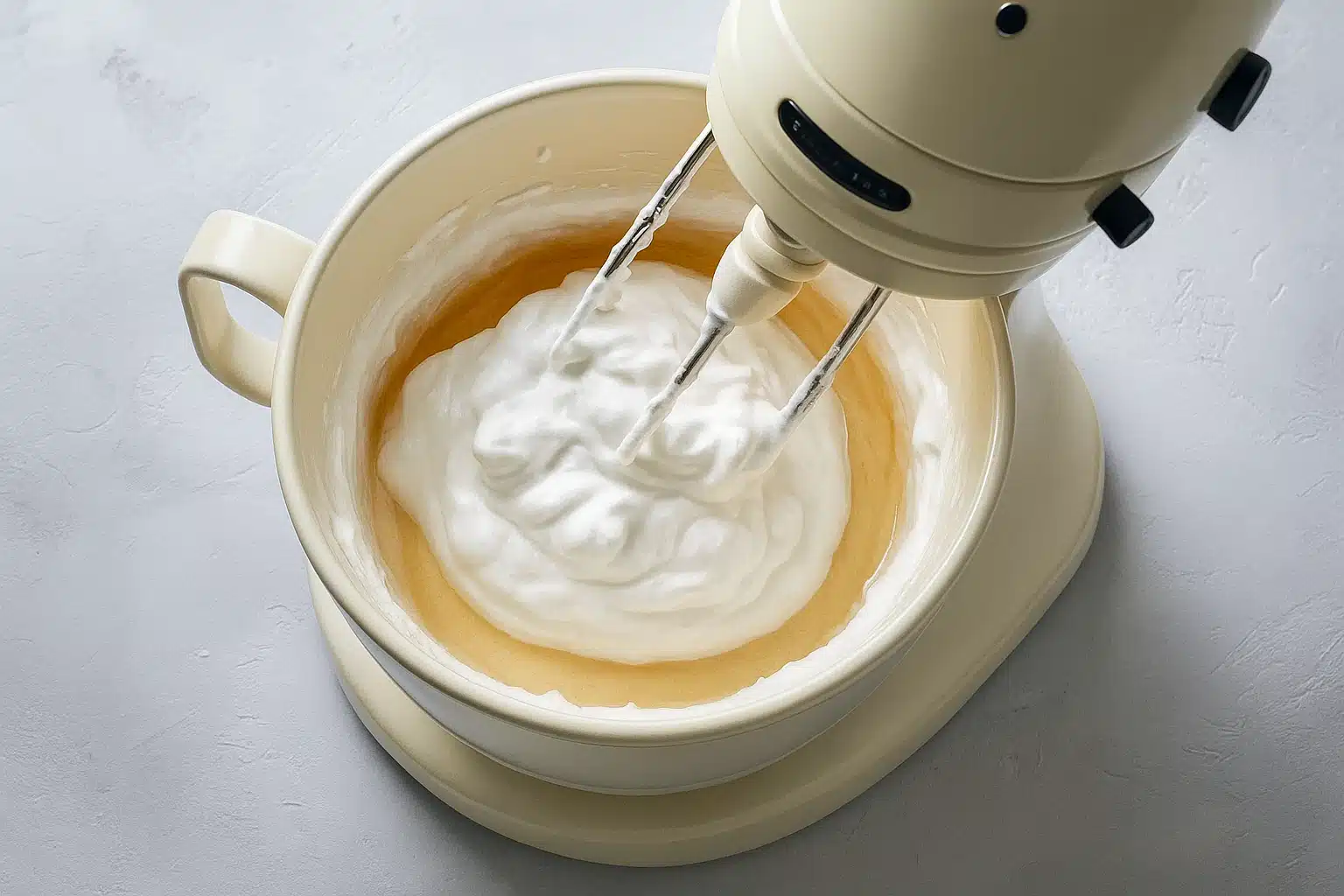
Essential Tools and Preparation Tips
Before you begin, gather your tools. Preparation makes all the difference between smooth success and a sticky disaster.
You’ll need:
- Stand mixer or hand mixer
- Saucepan
- Candy thermometer
- Silicone spatula
- 8×8-inch baking pan
- Sifter or fine mesh sieve
Lightly coat your pan with a mix of cornstarch and powdered sugar to prevent sticking. Keep all ingredients at room temperature for best results, especially the aquafaba.
How to Whip Aquafaba the Right Way
- Pour ¾ cup of aquafaba (liquid from canned chickpeas) into a clean mixing bowl.
- Add ½ teaspoon of cream of tartar to stabilize the foam.
- Whip on high speed for 10 to 15 minutes until you achieve stiff, glossy peaks.
The mixture should look just like whipped egg whites and hold its shape when you lift the whisk. Whipping aquafaba properly is key to achieving that airy, cloud-like texture found in marshmallows.
Cooking the Agar and Sugar Syrup to the Right Temperature
- In a medium saucepan, combine 1 ½ cups of sugar, ½ cup of water, and 1 tablespoon of agar agar powder.
- Place the pan over medium-high heat and stir gently until the sugar dissolves.
- Once the mixture starts boiling, reduce to medium and simmer until the temperature reaches 225°F–230°F (soft-ball stage) using a candy thermometer.
- Do not overcook, as it may cause the syrup to harden too much.
Agar agar activates only when boiled, so ensure you let it bubble for at least 4 to 5 minutes. This ensures a firm but fluffy texture.
Combining the Mixture and Setting Marshmallows for Best Results
- With the mixer running on low, slowly pour the hot agar syrup into the whipped aquafaba in a steady stream.
- Once all the syrup is added, increase the speed to high and whip for another 6 to 8 minutes until the mixture thickens, cools slightly, and turns glossy.
- Add 1 teaspoon of vanilla extract (or any preferred flavor) during the final minute.
- Quickly transfer the mixture to your prepared pan and spread it evenly using a greased spatula.
- Allow it to set at room temperature for at least 4 hours, preferably 6.
When set, dust the top with more of your cornstarch and powdered sugar mix. Carefully remove the marshmallow slab from the pan, cut it into cubes, and coat all sides to prevent sticking.
Pro Tips for Perfect Gelatin-Free Marshmallows
- Always use agar agar powder, not flakes, for accurate setting strength.
- Avoid high humidity while setting; moisture can affect texture.
- Don’t skip whipping time; it determines fluffiness.
- Store at room temperature in an airtight container lined with parchment paper.
These steps ensure you’ll end up with soft, springy, and totally gelatin-free marshmallows every time.
Creative Variations for Gelatin-Free Marshmallows
Once you’ve mastered the basic marshmallow recipe without gelatin, it’s time to get creative. The beauty of making your own marshmallows is the freedom to experiment with flavors, colors, and textures. Whether you prefer fruity, layered, or simple versions, these variations will help you personalize your treats for any occasion.
Fruit-Flavored Marshmallows: Natural Colors and Tastes
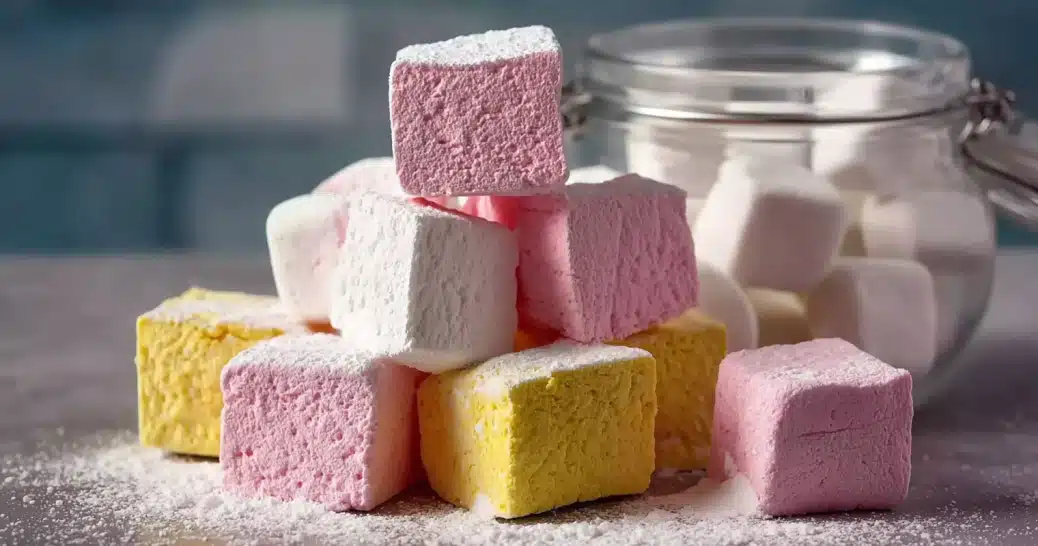
Adding fruit purees or extracts to your marshmallows gives them a refreshing twist. The key is to adjust the moisture level to keep the texture balanced.
- Strawberry Marshmallows: Blend and strain fresh strawberries, then fold 2 tablespoons of puree into the whipped mixture before it sets. Use beetroot or berry powder for a natural pink hue.
- Citrus Marshmallows: Add grated lemon or orange zest and a few drops of natural extract for a bright, tangy flavor.
- Blueberry Marshmallows: Stir in blueberry powder or puree for a purple tint and subtle sweetness.
For best results, use concentrated purees or powders instead of juices to avoid excess liquid that could affect the firmness.
Corn Syrup-Free Marshmallows for Healthier Choices
If you prefer natural sweeteners, this recipe already skips corn syrup. But you can take it further by experimenting with:
- Maple Syrup: Adds a rich, caramel undertone.
- Agave Nectar: Creates a mild sweetness and blends well with vanilla or fruit flavors.
- Coconut Sugar: Offers depth and a golden-brown finish.
These options not only enhance the flavor but also make your marshmallow recipe without gelatin feel lighter and cleaner.
Layered and Colored Marshmallows for Fun Desserts
Why settle for plain white marshmallows when you can create a rainbow effect? Divide your mixture into sections, tint each with natural powders, and pour them in layers before setting. Use:
- Spirulina powder for green
- Turmeric for yellow
- Pitaya or beet powder for pink
You can also swirl two colors together using a spatula for a marbled look. Once set, drizzle with vegan chocolate or dust with cocoa for extra indulgence.
3-Ingredient Marshmallow Recipe Without Gelatin for Quick Batches
Short on time or ingredients? You can still enjoy a fluffy batch using only three main ingredients:
- Aquafaba
- Sugar
- Agar agar powder
This minimalist version skips stabilizers and flavorings but delivers a fast, light marshmallow. It’s perfect for testing texture or making small batches for hot cocoa or s’mores.
Quick Note: These simpler marshmallows may not store as long as the full recipe, so enjoy them fresh within two days.
Serving Ideas and Presentation Tips
- Cut marshmallows into heart or star shapes for themed parties.
- Dust with cocoa powder or cinnamon for extra flavor.
- Dip half of each marshmallow in melted vegan chocolate and roll in shredded coconut for a gourmet touch.
- Pack them in glass jars tied with ribbon for a homemade gift idea.
These creative twists make your gelatin-free marshmallows fun to make and even more enjoyable to share.
Tips and Troubleshooting for Gelatin-Free Marshmallows
Even the most experienced bakers run into challenges when working with vegan or gelatin-free recipes. The good news is that most issues are easy to fix with a few key adjustments. This section will help you troubleshoot common problems and refine your marshmallow recipe without gelatin for consistently fluffy, delicious results.
Common Mistakes When Making Marshmallows Without Gelatin
1. Marshmallows Didn’t Set Properly
This usually happens when the agar agar wasn’t fully activated. Agar needs to boil for several minutes to form a stable gel. If you remove it from the heat too soon, your mixture may stay soft or sticky.
Fix: Boil the agar syrup for at least 4 to 5 minutes after it starts bubbling. Make sure the temperature reaches between 225°F and 230°F.
2. Marshmallows Are Too Firm or Rubber-Like
Too much agar agar or overcooking the syrup can make marshmallows tough.
Fix: Slightly reduce the agar amount next time or stop heating once the syrup reaches soft-ball stage.
3. Mixture Collapsed After Whipping
Aquafaba loses structure if it isn’t whipped long enough or if the syrup is poured too quickly.
Fix: Whip aquafaba until stiff peaks form and pour the syrup in a slow, steady stream while mixing continuously.
4. Marshmallows Taste Like Chickpeas
A common issue when using aquafaba is residual flavor.
Fix: Add strong vanilla extract, citrus zest, or almond flavoring to mask it completely. Using unsalted, mild chickpea liquid also helps.
How to Fix Marshmallows That Don’t Set or Stay Sticky
If your batch turned sticky or didn’t firm up, don’t toss it out yet. You can still salvage it.
- Reheat the mixture gently, then add a small amount of activated agar syrup to firm it up.
- Dust sticky pieces with cornstarch and powdered sugar mix to absorb excess moisture.
- Let them air-dry uncovered for 30 minutes before storing.
This quick fix often restores the right texture without changing the flavor.
Perfecting Texture and Flavor in Every Batch
- Always use room-temperature ingredients. Cold aquafaba won’t whip properly.
- Keep your mixing bowl oil-free. Even a little residue can prevent foaming.
- Add a few drops of lemon juice to help stabilize the aquafaba structure.
- For softer marshmallows, reduce the agar agar slightly; for firmer ones, add a bit more.
- To enhance flavor, mix in vanilla paste, espresso powder, or melted vegan chocolate before setting.
These tweaks can help you fine-tune the consistency and flavor to your personal taste.
How to Store Marshmallows for Freshness and Shelf Life
Proper storage is crucial for maintaining that light, fluffy texture.
- Room Temperature: Keep in an airtight container at room temperature for up to 7 days. Add a bit of the dusting powder to prevent sticking.
- Refrigerator: Optional, but it can extend freshness by 2 to 3 more days.
- Freezer: Not recommended, as the marshmallows may absorb moisture and become soggy after thawing.
Layer pieces with parchment paper to prevent clumping. Avoid plastic bags, which can trap moisture and alter the texture.
Quick Tip Table for Marshmallow Troubleshooting
| Problem | Likely Cause | Simple Fix |
|---|---|---|
| Too soft | Agar not boiled long enough | Boil syrup 4–5 min until 230°F |
| Too firm | Excess agar or overcooked syrup | Reduce agar slightly |
| Sticky | Moisture exposure | Dust with cornstarch-sugar mix |
| Chickpea flavor | Strong aquafaba taste | Add vanilla or citrus zest |
| Collapsed texture | Syrup added too fast | Pour slowly while mixing |
Following these simple tips ensures your gelatin-free marshmallows turn out perfect every time—light, airy, and melt-in-your-mouth delicious.
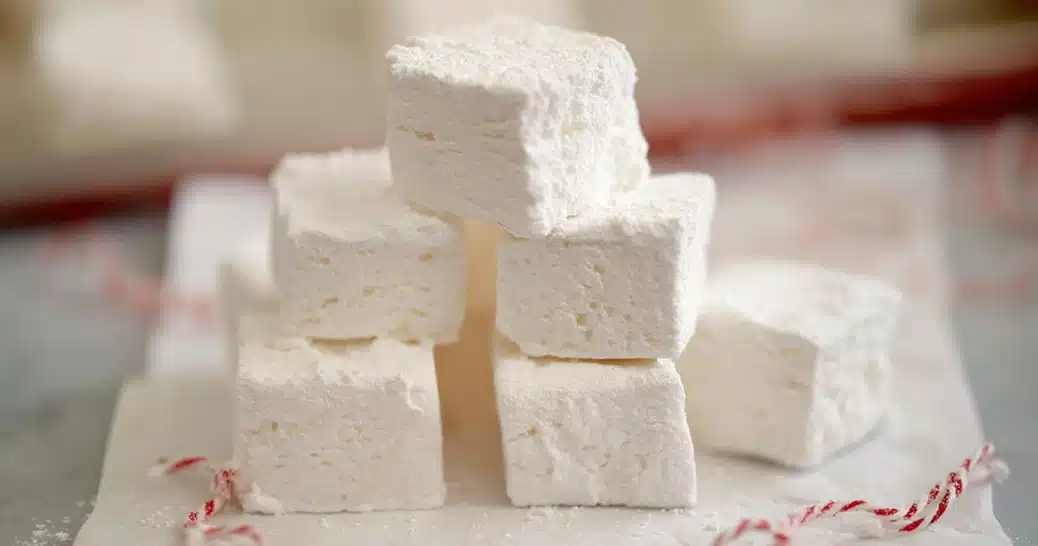
Comparing Gelatin vs. Gelatin-Free Marshmallows
Understanding how traditional and gelatin-free marshmallows differ helps you appreciate why a marshmallow recipe without gelatin can be just as good, if not better. While gelatin creates that bouncy, elastic texture, plant-based alternatives bring a cleaner, ethical twist without compromising taste or satisfaction.
Texture and Elasticity Differences
Traditional marshmallows made with gelatin have a springy, chewy bite. Gelatin-free versions, on the other hand, are often softer and slightly more delicate. Thanks to ingredients like agar agar and aquafaba, your marshmallow recipe without gelatin still holds its shape beautifully while offering a lighter, melt-in-your-mouth texture. The difference is subtle and often preferred by those who enjoy a creamier, less rubbery consistency.
| Feature | With Gelatin | Without Gelatin |
|---|---|---|
| Texture | Chewy and elastic | Soft, airy, slightly less bouncy |
| Setting Time | 20–30 minutes | 1–2 hours |
| Flavor | Neutral | Slightly sweet or flavored by natural substitutes |
| Shelf Life | 10–12 days | 7–9 days |
| Diet Compatibility | Limited | Vegan, halal, kosher friendly |
Flavor and Sweetness Profiles
In most cases, the flavor of gelatin-free marshmallows depends on your chosen gelling agent. Agar agar provides a neutral base, while marshmallow root and carrageenan can add mild earthy undertones. Using vanilla extract, maple syrup, or fruit purees enhances the sweetness and aroma naturally. Compared to traditional ones, these marshmallows often taste fresher and more customizable.
Dietary Compatibility: Vegan, Halal, and Kosher Options
One of the biggest advantages of making a marshmallow recipe without gelatin is inclusivity. Store-bought marshmallows containing gelatin exclude people following certain dietary lifestyles. Gelatin-free versions made with agar agar or pectin are suitable for:
- Vegans and Vegetarians: Completely plant-based, with no animal-derived ingredients.
- Halal and Kosher Diets: Agar agar and carrageenan meet religious requirements when sourced correctly.
- Allergy-Sensitive Diets: Avoids animal proteins that may cause reactions for some individuals.
Quick Comparison: Why Choose a Gelatin-Free Marshmallow Recipe
| Benefit | Gelatin Marshmallows | Gelatin-Free Marshmallows |
|---|---|---|
| Ethical and Sustainable | No | Yes |
| Plant-Based | No | Yes |
| Easy to Customize | Moderate | High |
| Suitable for All Diets | Limited | Inclusive |
| Texture Preference | Firm and chewy | Soft and fluffy |
Choosing a marshmallow recipe without gelatin supports sustainability, ethical eating, and inclusivity while maintaining indulgence. It’s the perfect way to enjoy your favorite treat without compromise.
Delicious Ways to Use Marshmallows Without Gelatin
Homemade marshmallows are more than just cute little cubes of sweetness. Once you’ve mastered your marshmallow recipe without gelatin, the possibilities for using them are endless. From cozy winter drinks to layered desserts, these vegan-friendly treats can transform any simple recipe into something special.
Homemade Hot Cocoa with Vegan Marshmallows
Nothing beats a warm mug of hot cocoa topped with fluffy marshmallows that melt just right. When using your gelatin-free version, you get a soft, creamy texture that blends perfectly with the rich chocolate.
Tip: Sprinkle a pinch of cinnamon or sea salt on top for an extra flavor twist.
For an indulgent variation, swirl in coconut milk or almond milk for a dairy-free delight that complements the lightness of your marshmallows.
S’mores Made with Gelatin-Free Marshmallows
Yes, you can absolutely make s’mores without gelatin-based marshmallows. Your homemade vegan marshmallows toast beautifully over low heat and become deliciously gooey in seconds. Layer them between whole grain crackers and dark chocolate for a completely plant-based version of the classic treat.
Serving idea: Use flavored marshmallows, such as strawberry or vanilla, to add a unique twist to your s’mores experience.
Marshmallow Cake and Dessert Fillings
Your marshmallow recipe without gelatin doubles perfectly as a filling for desserts. The soft, airy texture is ideal for cupcakes, whoopie pies, or layered cakes.
- Spread between sponge cake layers for a light, fluffy filling.
- Fold into whipped coconut cream for a vegan marshmallow mousse.
- Use as a topping for brownies or rice crisp treats for an extra-sweet bite.
If you slightly under-whip the aquafaba mixture, you’ll get a smoother, more spreadable texture that works wonderfully for fillings and frostings.
Gift Ideas with Homemade Marshmallows
These marshmallows make great edible gifts for holidays and special occasions. Once set and cut, coat them in cocoa, matcha, or powdered sugar and pack them in airtight jars tied with ribbons. Add a personalized label like “Vegan Vanilla Marshmallows” or “Homemade Treats Without Gelatin.” They store well at room temperature for up to a week and are perfect for thoughtful, homemade presents.
Other Fun Ways to Enjoy Marshmallows Without Gelatin
- Hot Coffee Toppers: Drop one or two into a cup of hot coffee or latte for instant sweetness.
- Breakfast Boost: Dice a few pieces and sprinkle them over oatmeal or smoothie bowls.
- Ice Cream Add-Ins: Mix small marshmallow cubes into your favorite dairy-free ice cream.
- Party Snacks: Skewer marshmallows with fruit pieces for colorful dessert kebabs.
These serving ideas show just how versatile a marshmallow recipe without gelatin can be. Whether you prefer simple indulgence or creative desserts, your homemade version fits every occasion.
Conclusion and Final Thoughts
So, can you really make soft, fluffy marshmallows without using gelatin? Absolutely. With the right ingredients and simple techniques, a marshmallow recipe without gelatin delivers the same bounce, sweetness, and joy as any traditional version. Using agar agar and aquafaba not only provides the structure and texture you need but also keeps the recipe completely plant-based and cruelty-free.
A gelatin-free marshmallow recipe proves that you don’t have to compromise on taste to honor your dietary choices. Whether you’re vegan, vegetarian, halal, or kosher, this approach ensures that everyone can indulge in this nostalgic treat. You can even personalize your marshmallows with flavors, colors, and natural sweeteners to make them uniquely yours.
Beyond the flavor, making your own marshmallow recipe without gelatin is an experience. From whipping the aquafaba to watching the mixture set into soft, pillowy cubes, every step feels rewarding. And the best part? You know exactly what goes into your sweets. No hidden ingredients, no animal products, just pure, fluffy goodness.
If you’ve been craving a guilt-free dessert that melts in your mouth, now’s the perfect time to try this recipe. So grab your whisk, open a can of chickpeas, and transform simple ingredients into light, spongy marshmallows that everyone can enjoy.
Love this marshmallow recipe without gelatin? We’d love to see how your vegan marshmallows turn out. Share your delicious results and tag us for a chance to be featured.
Follow and Share:
- Pinterest
Discover more plant-based desserts, vegan sweets, and no-gelatin recipes on our Pinterest boards. - Facebook
Join our food-loving community for new recipes, kitchen tips, and behind-the-scenes videos.
Keep spreading sweetness with your homemade creations. Every fluffy bite of your marshmallow recipe without gelatin makes the world a little softer.
FAQs About Marshmallow Recipe Without Gelatin
What is a substitute for gelatin in marshmallows?
The best substitute for gelatin in marshmallows is agar agar, a plant-based gelling agent made from seaweed. It sets firmly and creates a texture similar to traditional marshmallows. Other options include carrageenan, pectin, and marshmallow root, each offering different firmness levels. For the fluff factor, combine agar agar with aquafaba, which mimics the function of whipped egg whites. This combination gives a perfect, airy structure in any marshmallow recipe without gelatin.
How to make marshmallows without gelatine?
To make marshmallows without gelatine, whip aquafaba with cream of tartar until stiff peaks form, then mix it with a boiled syrup made from sugar, water, and agar agar powder. Pour the combined mixture into a dusted pan, allow it to set for several hours, and then cut into cubes. Coat the pieces in a cornstarch and powdered sugar mix to prevent sticking. This easy method yields fluffy, bouncy marshmallows with no animal products required.
What marshmallows have no gelatin?
Many homemade and store-bought marshmallows are made without gelatin. Brands like Trader Joe’s Vegan Marshmallows, Dandies, and Freedom Mallows use plant-based gelling agents such as carrageenan or agar agar. If you want complete control over ingredients, a homemade marshmallow recipe without gelatin ensures that your marshmallows are vegan, halal, and kosher-friendly.
Do Trader Joe’s marshmallows have gelatin?
No, Trader Joe’s regular marshmallows are gelatin-free and vegan-friendly. Instead of gelatin, they use carrageenan, a natural thickener derived from seaweed. This makes them suitable for most diets, including vegan, halal, and kosher lifestyles. Their texture is soft and sweet, closely matching traditional marshmallows, making them a reliable store-bought option if you don’t have time to make your own.
Are gelatin-free marshmallows healthy?
While marshmallows are still a sweet treat, those made without gelatin can be slightly healthier because they avoid animal collagen and can use natural sweeteners like maple syrup or agave. A homemade marshmallow recipe without gelatin lets you control sugar levels and skip artificial additives, creating a cleaner, more natural dessert.
Can I use pectin or marshmallow root instead of agar agar?
Yes, both pectin and marshmallow root can replace agar agar, but the results differ. Pectin makes the texture softer and more jelly-like, while marshmallow root adds natural thickening and a subtle earthy note. For best results, mix them with aquafaba or egg white for better structure and fluffiness.
These answers help clear the most common questions people ask about making marshmallows without gelatin, covering both ingredients and techniques for a successful result every time.

